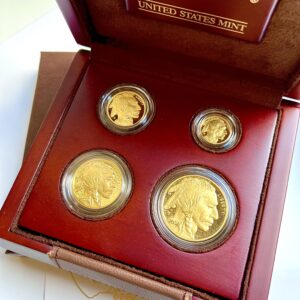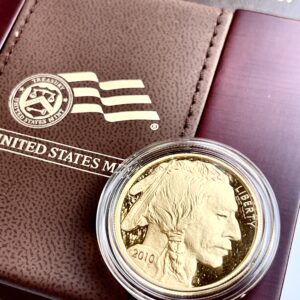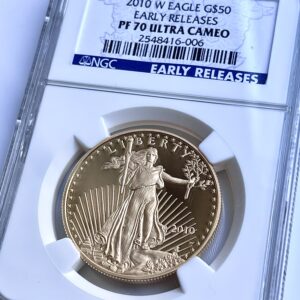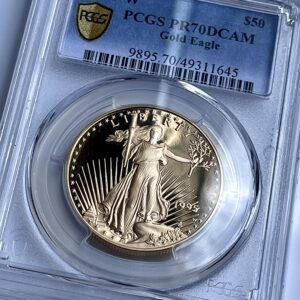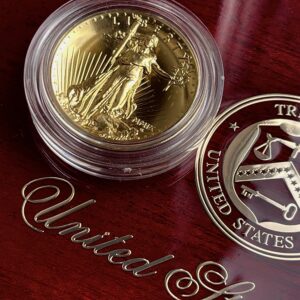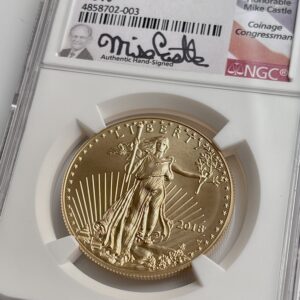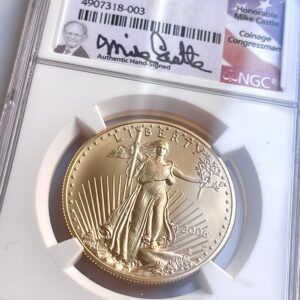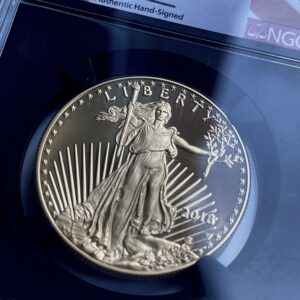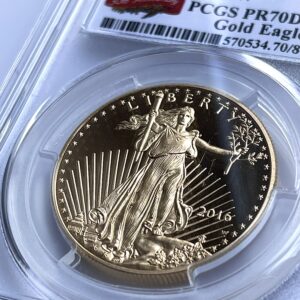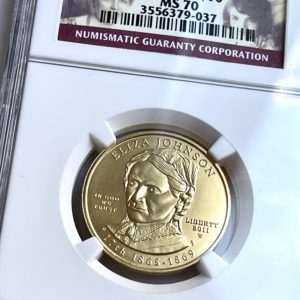
Exploring iconic US gold coin series
Immerse yourself in the rich history and enduring appeal of iconic American gold coin series, each a testament to the nation’s numismatic heritage and artistic genius. From historic treasures to modern wonders, these coin series offer collectors a glimpse into America’s past and present.
The American Eagle Gold Proof Coin and the Saint Gaudens Gold Coin: A History of Art, Heritage and Symbolism
The United States Mint has issued special editions of official bullion coins since 1986, known as American Eagle Gold Proof coins. These coins are aimed at collectors and are available in four different sizes: 1 ounce, ½ ounce, ¼ ounce and 1/10 ounce. Each American Eagle Gold Proof coin is made of 91.67 percent (22 karat) gold. The weight and diameter of the coins vary depending on their denomination. The US Mint ‘s West Point mint produces these coins and they bear the “W” mintmark.
The image of the goddess of freedom (Liberty) adorns the front of the coins, which has been found on gold coins since 1986. The design is inspired by the famous 1907 $20 “Double Eagle” gold coin designed by Augustus Saint-Gaudens. In 2021, the Mint celebrated the 35th anniversary of the American Eagle Coin Program with a design update. To achieve a closer resemblance to Saint-Gaudens’ original vision, the mint used historical materials such as the original bronze casting. Changes were made to elements such as the Capitol building, stars, torch, sunbeams and other design elements.
From 2021, the reverse of the coins will show the portrait of an eagle. To enhance the security of the new coins, additional security features have been incorporated, including a change in the edge pattern, which now features a fluted edge.
From 1986 to 2021, the reverse of the coins featured an eagle carrying an olive branch and flying over a nest containing a second eagle and its young. This motif was designed by the sculptor Miley Busiek and maintained throughout these years.
In 2020, the U.S. Mint released a special edition American Eagle Gold Proof Coin to commemorate the 75th anniversary of the end of World War II. This special edition was minted with the “V75” mintmark, depicting the shape of the Rainbow Basin at the World War II Memorial in Washington, DC.
What is a Saint-Gaudens gold coin?
The Saint-Gaudens gold coin, also known as the Saint-Gaudens-double eagle, is a twenty-dollar gold coin minted by the United States Mint between 1907 and 1933. It was created by sculptor Augustus Saint-Gaudens, who designed both the obverse and reverse of the coin. It is known for its aesthetics and is considered by many to be the most beautiful coin in the history of the United States.
Who was Augustus Saint-Gaudens?
Augustus Saint-Gaudens, born March 1, 1848 and died August 3, 1907, was an important American sculptor who belonged to the Beaux-Arts movement and embodied the spirit of the American Renaissance. He came from an Irish-French family and grew up in New York City before embarking on a journey to Europe to further his artistic education and studies. Upon his return to New York, he gained wide recognition for his sculptures honoring American Civil War heroes, many of which still exist today.
Saint-Gaudens and numismatics
Saint-Gaudens also applied his design skills to the field of numismatics. He referred to his early relief portraits as “medallions” and had a deep interest in the art of coinage. One of his notable contributions was the design of the $20 gold piece, known as the double eagle coin, which he designed for the U.S. Mint between 1905 and 1907. Despite some changes made for minting purposes, this coin is still considered one of the most beautiful American coins ever issued.
Saint-Gaudens was chosen by Theodore Roosevelt to revamp the nation’s coinage in the early 20th century, and created a version of the $20 gold piece with extremely high relief. These coins required up to 11 strikes to bring out the intricate details, and only a small number, about 20, were struck in 1907. However, due to stacking problems and unsuitability for daily use, they were considered unsuitable for circulation. Today these coins with extreme high relief are very sought after.
To address stacking and practicality issues, a high-relief version of the coin was created that requires eight fewer mintages than the ultra-high-relief version. A total of 12,317 of these high relief coins were minted, which are currently in high demand among collectors. Finally, a version with normal relief was developed, which was produced from 1907 to 1933. This particular design, known as the “ultra-high relief” $20 coin, was successfully minted in 24-karat gold, resulting in the production of 115,178 coins. The US Mint issued this coin in 2009.
Who was the model for the St. Gaudens gold coin?
Hettie Anderson, an African American model, played an important role in the design of iconic coins by famous artists such as Augustus Saint-Gaudens and Adolph Weinman. She was the preferred Liberty chosen for Saint-Gaudens’ Eagle and Double Eagle coins, as well as Weinman’s Walking Liberty half-dollar coin.
Interestingly, the identity of the stunning female figure depicted on the eagle coins remained a mystery to most people for many years, with the exception of Saint-Gaudens’ immediate family, friends and colleagues. Saint-Gaudens’ family intentionally kept this information secret, possibly because of Anderson’s background. Fortunately, the nearly century-old secret was revealed, and Hettie Anderson finally received the recognition she deserved.
While other models were credited for Weinman’s walking Liberty half-dollar coin, Weinman himself described Hettie’s appearance without specifically mentioning her name, probably because she was African American.
Born in South Carolina in 1873, Hettie Anderson was a successful model who later moved to New York City. Her career was quite unusual for a dark-skinned woman at that time. Not only did she pose as the Liberty figure for the Saint-Gaudens twenty-dollar gold coin, but she also represented the Victory figure for the Sherman Monument.
Where does the name “Double Eagle” come from?
The coin got its name because the original Gold Eagle, minted starting in 1795, had a face value of $10. Since this particular coin has a face value of $20, it effectively represents twice that value, hence the name “Double Eagle.”
Exploration of the American Buffalo Gold Proof Coins
The American Buffalo Gold Proof coins are very popular with collectors worldwide. These exquisite coins are minted at the West Point Mint, a U.S. Mint production and storage facility established in 1937 near the U.S. Military Academy at West Point, New York, USA. Since their introduction by the United States Mint, American Buffalo Gold Proof coins have had a rich history and a special place in the hearts of numismatists around the world.
The beginnings of American Buffalo Gold Proof coins
The roots of the American Buffalo Gold Proof coin can be traced back to the early 20th century when the legendary Buffalo Nickel was introduced in 1913. This nickel, designed by renowned sculptor James Earle Fraser (1876-1953), featured the profile of a Native American on the obverse and a majestic American bison on the reverse. Fraser’s design, which captured the spirit of the American West, quickly became an iconic symbol of American coinage.
Inspiration for the American Buffalo Gold Proof coins
Inspired by the timeless beauty of the Buffalo Nickel, the United States Mint decided to revive the design in a new format. In 2006, the American Buffalo Gold Proof coin was introduced, the first 24-karat gold coin ever struck by the U.S. Mint. The use of .9999 fine gold makes this coin one of the purest gold coins ever produced in the United States.
Design and creation
The obverse of the American Buffalo Gold Proof coin features a faithful replica of Fraser’s Native American profile. The ornate details, such as the feathers on the headdress and the striking facial features, testify to the craftsmanship and artistic quality of the US Mint. On the reverse, the majestic American bison, a symbol of the American frontier, stands high on a hill. The detailed depiction of the bison’s muscular figure and its shaggy fur makes this coin a true masterpiece.
Letters on the coins
The letters “W” and “F” on the American Buffalo Gold Proof coins have a special meaning. On the face of the coin there is the motto “LIBERTY” at the top right, the year of minting at the bottom left and the letters “W” for West Point and “F” for Fraser below. The “W” mint mark is only found on the Proof version of the coin and is located behind the neck of the Indian depicted on the coin. The bullion version of the coin does not bear the “W” mintmark.
Popularity and value
The American Buffalo Gold Proof coin has quickly gained popularity among collectors and investors around the world due to its exceptional beauty, historical significance and high gold content. Each coin is minted multiple times to achieve a flawless proof surface, resulting in a deep, mirror-like background that highlights the complex design. The limited edition of these coins makes them even more desirable and collectible.
Investment opportunity
The American Buffalo Gold Proof coins are not only sought-after collector’s items, but also a valuable investment. The high gold content and limited mintage make these coins an attractive option for those looking to diversify their investment portfolio with precious metals.
A look at the US Mint’s First Spouse gold coin series: A tribute to the First Ladies of the United States
The coins honoring the First Ladies, also known as First Spouse gold coins, were issued between 2007 and 2016 to honor the wives of former U.S. presidents, who are featured on the $1 presidential coins issued during the same period. Although the series initially sold well and the first designs were produced in large quantities, demand later became less than expected. This led to a reduction in the number of coins produced and, in later years, to a shortage of certain coins, making them highly sought after collector’s items.
Among the coins in the series, the 2007 Liberty Coin, which features the image of Thomas Jefferson, has the record for Proofed Mintage: 19,823 Uncirculated and 19,815 Proof coins were minted (39,638 total coins). At the other end of the spectrum, there were only 2,168 uncirculated Lucretia Garfield coins.
First Lady Coins Design
United States law prohibiting the depiction of living persons on currency included only deceased first ladies in the design of the coins. The series began with Martha Washington and ended with Nancy Reagan. All coins have a standard diameter of 26.49 mm and thickness of 1.88 mm.
In cases where presidents such as Thomas Jefferson and James Buchanan were unmarried or widowed during their time in office, the obverse of the coins features the image of Liberty instead of a portrait. The reverse side shows a picture depicting the most important issues related to the life or term of office of each president. One exception was Chester A. Arthur’s coin, which featured women’s rights activist Alice Paul during his tenure.
The portraits of the First Ladies are depicted on the obverse of the coins, with their names and the terms of office of their husbands above the portraits. Other inscriptions include “In God We Trust” on the left side of each portrait, while the right side reads the word “Liberty” and the year of issue.
The reverse of each coin features an illustration depicting important aspects from the life of the respective First Lady. Other inscriptions include “United States of America,” “E Pluribus Unum,” and the coin’s specifications, including the face value of $10, the weight of ½ ounce (troy ounce), and the quality mark of .9999 (24-karat gold). .
The American Liberty gold coin and the Liberty motif on US coins
The “American Liberty” gold coin honors the American ideal of freedom, which is traditionally symbolized by a female figure. It was first launched in 2015 and has been published every two years since then.
The United States Mint branch at West Point issues this gold coin. Each coin weighs one ounce and is made with a “high relief” die. This special embossing technique gives the coin image a three-dimensional effect, meaning that the design elements stand out more clearly from the background compared to conventional embossing.
Interesting facts about the Liberty motif on US coins
The depiction of Liberty, the goddess of freedom, has a long tradition in the USA, dating back to the founding of the United States Mint in 1792. The depiction of Liberty was required by law for the classic US gold coins of the 18th century, 19th and early 20th century.
The most popular modern gold and silver coins from the United States Mint also show Liberty on the motif side: The American Gold Eagle presents Augustus Saint-Gaudens’ Liberty in front of the rising sun, while the American Silver Eagle shows Adolph A. Weinmann’s Striding Liberty.
These are just a few examples of well-known American gold coin series that have left an indelible mark on numismatic history. Whether you are drawn to classic designs or modern masterpieces, exploring these series offers a fascinating journey through America’s rich coinage tradition.
Additional resources on modern U.S. gold coin series:
American Eagle and Saint-Gaudens Double Eagle
Current US gold coins in stock are listed as follows. If you are looking for another US gold coin, please do not hesitate to contact us directly. Many of these coins are in high demand and sell quickly. However, we have a global network of coin collectors and can also find your special coin for you.

